
|

60 MILES AFTER
LOSING SALIENT
HQ., U.S. CHINESE COMBAT COMMAND, May 31 - (Special to The China Lantern) - While hard hit Japanese forces this week licked their wounds and brooded over blasted offensive dreams in Hunan Province, far to the southwest in Kwangsi Province other elements of the resurgent Chinese Army added two important new victories to the steadily brightening central and south China picture.
These came with the reoccupation by the Chinese, early in the week, of the important north Kwangsi city of Hochih and later in the week by the recapture by the Chinese, in southern Kwangsi, of Nanning, former U.S. Fourteenth Air Force base and key communications center. Following these successes, Chinese troops pushed almost 60 miles eastward from Hochih along the road and reached the vicinity of Ishan. In the Nanning area, after the city's capture the Chinese pursued the divided remnants of the Japanese garrison northeastward toward Pinyang and southwestward toward Sohu, which was captured.
HOCHIH WAS JAP SALIENT
Although neither of these key points was occupied by the Chinese without heavy fighting, inability or refusal of the Japanese High Command to go to desperate lengths to hold both cities is causing considerable speculation in Allied circles. Hochih has been for more than a year, the spearhead of a Japanese salient pointing northwestward toward the U.S. Chinese base at Kweiyang, which makes a Japanese retreat of almost 60 miles in one week in this area of considerable significance.
NANNING LOSS MAY MEAN CHANGE OF STRATEGY
Nanning in addition to being an air base within easy range of Japanese air traffic along the south China and Indo-China coasts, is a terminal point for river shipping on the West river from the Hongkong-Canton area westward and stands at the crossroads of two Japanese corridors, one west along the river from Canton, and the other northeast toward central China from French Indo-China. Permanent loss of Nanning in particular may point to a major revision of Japanese strategy in the Kwangsi area.
In Hunan Province, although hard fighting continued in various sectors during the week just ending, the main issues of the battle appear to have been decided in favor of the Chinese and present action is devoted mostly to mopping up stragglers and consolidating positions.
RETREATING JAPS LIQUIDATED
South of the main Chihkiang-Paoching road, the Chinese liquidated retreating Japanese elements or forced them eastward across the Fu-I-Shui and Tzu rivers.
Taohuaping, 25 miles east of Paoching on the main road, changed hands twice during the week but is now held by the Chinese. North and east of Taohuaping, the Japanese are slowly but steadily being forced south and east from the Liping area.
This puts the opposing forces in essentially the same position as that from which the Japanese launched their ill-fated and costly offensive toward Chihkiang early in April.
|
Wedemeyer Praises
Cheves’ CT Work
CHUNGKING - Maj.Gen. G. X. Cheves, commanding general of the Services of Supply U.S. Forces, China Theater, has completed his assigned task of reorganizing SOS facilities in China and has returned to the United States.
|
Gen. Cheves came to China at the personal request of Lt.-Gen. A. C. Wedemeyer, commanding general, USF, CT.
Lt.-Gen. Wedemeyer had high praise for Gen. Cheves' work in this theater.
"Both Americans and Chinese have uniformly expressed admiration for Gen. Cheves' efforts and appreciation of his accomplishments in the past six months," the General said. :Our good wishes follow him in his future endeavors."
Before his arrival here in November, 1944, Gen. Cheves had developed the great Allied supply port of Calcutta and had commanded the U.S. SOS in the Middle East.
In China he utilized the experience that he had gained in India and the Middle East, rapidly developing the reorganization of the "longest supply line in the world."
It is recognized by all military men that the China Theater presents one of the most difficult supply problems.
Today an ever-increasing stream of supplies flows into China over the famed "Hump" of the Himalayas, across the winding Stilwell Road, and through the very recently completed oil pipeline.
|
Chinese Officers
Graduated At ITC
CHINESE TRAINING CENTER, U.S. ARMY - More than one hundred Chinese Army officers, ranging from lieutenant to colonel, received diplomas at graduation exercises of the first class of the re-activated Infantry Training Center, one of the several schools for improving the combat efficiency of the Chinese now in operation in Yunnan Province under the U.S. Army's Chinese Training Center.
Maj.-Gen. Liang Hwa-Sheng, commandant of the Yunnan Training Command, a veteran of more than a hundred battles against the Japanese; and Col. Mose Kent of El Paso, Texas, commandant of the ITC, addressed the graduates.
Gen. Liang said that as a result of the training they had received in the intensive eight weeks' course at ITC, the officers would return to their units qualified to pass on to their troops serving under them the knowledge of modern infantry technique and tactics they had learned. Col. Kent spoke in a similar vein, declaring that is had been a pleasure to work with the members of the class and lauding them for the interest they had taken in perfecting themselves in modern infantry tactics.
The course which the students took at ITC included infantry weapons; individual, platoon and squad tactics; company, battalion and regimental tactics; heavy weapons; communications; first aid; sanitation and engineering. The courses are patterned after those given at the U.S. Army Infantry School at Fort Benning, Georgia.
Stratemeyer, USAAF To Leave Eastern Air Command
AIR COMMAND, SOUTH EAST ASIA, May 31 - Maj.-Gen. George E. Stratemeyer today relinquished command of Eastern Air Command from which American units have been withdrawn. He remains commanding general of the U.S. Army Air Forces in the India-Burma Theater.
He is succeeded as Air Commander by Air Marshal W. A. Coryton, who has been Assistant Air Commander since December, 1944 and Eastern Air Command becomes an RAF formation. The Air Marshal remains Air Marshal Commanding, Royal Air Force, Burma.
In a special Order of the Day, Air Marshal Sir Keith Park, Allied air commander-in-chief, South East Asia, says, in part:-
"Having taken a vital part in the defeat of the Japanese in Burma, USAAF units are being withdrawn from Eastern Air Command to fight the Japs again in another theater. The closing down of the fully integrated Eastern Air Command Headquarters is therefore an important milestone in the war against Japan.
TRAGIC ERROR CAUSES DEATH OF ATC SGT.
1340th ATC BASE, KUNMING - Mistaking a high-tension wire for a clothes line caused the almost instantaneous death of Sgt. George Aceveto, Brooklyn, N.Y., and a Tech Inspector at this base, recently.
Aceveto had been washing his clothes and went outside to hang them up to dry. An apparent clothes line was hanging outside his barracks and this seemed to him to be suitable.
Previous to this a pole, carrying 220 volts Chinese current, and at the corner of his barracks had begun to sag, apparently not being sufficiently deeply embedded in the earth. A slight rain earlier had softened the earth and this coupled with the fact that the pole had no guide wires to counterbalance the heavy wire load at the top caused the pole to lean towards the barracks and dropped the high tension, uninsulated power line to about shoulder height. It was this that Sgt. Aceveto mistook for a clothes line.
The ground around the wire was wet and so too were the clothes that the sergeant had in his hands. The result was electrocution and death.
M/Sgt. Elmar J. Warren, 1350th BU Air Inspector of Berlin, Md., happened to be nearby and heard the screams. Being well-versed in First Aid he immediately applied artificial respiration and continued this until the medical officer arrived. Everything possible was done but the shock had been too great and Sgt. Aceveto died about a half hour later.
Sgt. Kenneth W. Griffin, Washington, D.C., a refueling man with the 1340th BU and a very close friend of Sgt. Aceveto's said that the sergeant had several years of civilian experience plus that in the Army with electricity and was a man who would normally take all due precautions in such a case and that the average individual, in such a case, would be equally likely to mistake the wire for a clothes line and certainly not a high power wire.
CORREPONDENT FINDS -
A Chinese Dollar Bill Will Almost Buy A Shelled Peanut
By ALBERT RAVENHOLT
KUNMING, May 31 (UP) - When a friend remarked to me one evening at dinner that one Chinese dollar bill would now almost buy a single shelled peanut I determined to discover how skyrocketing inflation has affected the lives of the little people in this city, which is China's gateway to India and Burma.
Though the official exchange rate remains pegged at six Chinese dollars for one rupee, black market exchange operators on Kunming's cobbled streets offer anywhere up to 260 (two hundred and sixty) Chinese dollars per rupee. The exchange rate they quote is for one hundred rupee notes which are in great demand among smugglers bringing illicit goods in from India.
(Editor's Note: One Rupee is worth approximately $.30 in American money.)
PROFESSIONAL MEN, CLERKS, COOLIES HIT HARDEST
Though the price of everything from peanuts to simple cotton cloth has climbed steadily, the Chinese professional man, clerk and coolie has suffered most from the multiplying cost of rice, his staple food. Calculated at the exchange rate of CN$260 for one rupee, one maund of 82 pounds of fairly high quality rice costs Rs. 110.
A sampling of food prices at one of Kunming's largest markets gives a glimpse of the difficulties a Chinese professor, on a largely fixed salary, has in maintaining his family. Translated into rupees at the black market exchange rate they read: Eggs... Rs.2/5 for ten; Chicken... Rs.4/9 per pound; Fish... Rs.6/- per pound; Sugar... Rs.4/6 per pound and flour... Rs.2/- per pound.
RICE ALLOWANCE
In an effort to keep pace with mounting prices, Government employees and workers in larger banks and factories are paid a basic monthly wage and then either given a "rice allowance" or "Government rice" - estimated on the quantity of a rice man and his family will eat in a month. Rice for Government workers comes mainly from the land tax, which is collected in kind instead of cash, while large companies purchase stocks of rice at the same time they negotiate contracts, to insure that a mounting cost of living won't wipe out their margins.
COTTON SUIT COSTS CN$10,000
Even a Government employee, with his basic rice needs provided for, has little hope of supplying himself with anything except the barest essentials. A plain blue cotton suit, com[posed of trousers and coat, costs 10,000 Chinese dollars or 38 rupees at the black market exchange rate.
It is paradoxical that though China has been blocked from the outside world for nearly three years almost anything can be bought in the gaudy shops lining Kunming's streets - for a price.
Anyone with sufficient bundles of Chinese currency can buy a new "Omega" gold wrist watch for CN$450,000. Silk from Shanghai, fountain pens from the United States and gold bullion in tolas from India, can all be bought over or under the counter. The wealthy who buy them crave these luxury items not do much for use but as a reserve against inflation.
For more than four years observers have repeatedly predicted collapse or at least economic chaos as a result of China's steadily accelerating inflation. Dr. T. V. Soong, now China's Foreign Minister and president of the Executive Yuan, is quoted as having said, when asked about his country's falling currency: "It's something like the man who fell from the roof of a twenty story building. As he passed the eighth floor he remarked: "So far, so good."
BUSINESS CLASS LEAST EFFECTED
The business classes and the peasants generally have suffered less from the mounting costs of living than others. As prices have climbed, so has the value of the goods they have in stock.
A rickshaw coolie laughed bitterly when I asked him how he managed to live. He pointed to a wad of notes in the leather pocket on his belt (the recent issue of 400 and 500 dollar notes has simplified large transactions in cash) and said:
"Half of this goes tonight to the man who owns the rickshaw. With the rest I can buy all the rice I can eat at one meal, a dish with meat and soup. But 'aeya,' the pieces of meat are so small you can hardly find them, and the soup, it's mostly boiled water."
He, like the great majority here, somehow continue to live - but on a very narrow margin.
|
THUNDER-DRAGON MEN WHISTLE AS THEY WORK HQ., WEST CHINA RAIDERS - Rear echelon members of the Thunder-Dragons fighter group in China are swinging and swaying through their details these days, thanks to a camp wired for sound and a "Music Box" maintained by three rhythm-conscious sergeants.
The sergeant and his helpmates, Sgt. Marlin P. Otto, Lodi, Wis., and S/Sgt. Alvin C. Church, Crafton, Pa., installed a public address system in the Thunder-Dragons camp, with speaker outlets covering the entire area. Then the men took over a small room at the end of the compound. They equipped it with "PA" amplifier, radio microphone, a rebuilt turn-table and record player and Watt's "Morale Factory" was opened for business - and pleasure. Music, entertainment and news, picked up on the radio and rerouted through the public address system are the sergeant's main commodities. He monitors the radio in search of the best programs to send out over the area speakers, and fills in the lulls with a bit of jive churned out by the record player. The group network also functions as an information and public service bureau. Frequently a musical program is interrupted for a special, or momentous announcement, such as: "The laundry is in," or "No letter today, sorry," or "Pvt. Joe Doakes better report to the orderly room immediately or he'll be sorry. His rotation papers just arrived." That the sergeant's morale-elevating department has served its purpose is evident from the recent comment of one of the listensers. "I thought I'd never see the day when I could be on a GI detail and happy, too. But how can a guy be grumpy with Bob Hope or some other wise-cracker spouting humor all over the place." |
|
|
Col. McClure New Chief Of FATC CHINESE TRAINING CENTER - Col. Swinton I. McClure, Ithaca, N.Y., has been appointed commandant of the Field Artillery
Col. McClure, before his transfer to the FATC was chief of staff of CTC. He was formerly professor of military science and tactics at Cornell University. He is a graduate of George Washington University, BS 1915, ME 1916, and a member of Kappa Sigma. He also graduated from the Command and General Staff School at Fort Leavenworth and the Field Artillery School at Fort Sill, Okla. Col. McClure is a Regular Army Field Artillery officer and before coming overseas in April 1944, saw service at Camp Adair, Oregon with the 96th Division and at Headquarters of the Army Ground Forces, War College, Washington, D.C. He also served in the Panama Canal Zone during February and March 1944. He graduated from the Iola High School, Kans., before entering college. Masons Clubs To Hold Meetings This Week KUNMING - Kwei Chu Hli, the club of American and Chinese Army officers who are Master Masons, will meet Monday, June 4 at 6:30 p.m. in the Red Cross Town Club. Following dinner the group will go to nearby Hostel 14 for an entertainment program which will include a talk on "Development of Chinese Industry During War" by Mr. K. T. Kwo, assistant general manager of the Yaulung Electric Power Co., of Kunming. There will be election of a new president and other officers. The regular monthly meeting of the Enlisted Men's Masonic Club will be held in the Hotel du Commerce on Tuesday, June 5, at 7 p.m. T/Sgt. Jackman, chairman, and his entertainment committee, have an interesting meeting planned. All Enlisted Men who are Masons are invited to attend. |
|
To Avoid Criticism In China
KUNMING - In an effort to forestall criticism of American troops in the overcrowded Kunming area an extensive campaign through unit commanders will be undertaken immediately to promote courtesy, better military appearance, and good conduct in presence of civilians.
Lt.-Col. Henry G. Thomas, Washington, D.C., assistant theater provost-marshal, has enlisted the aid of several staff sections of Headquarters, Services of Supply, which is entrusted with the responsibility for dealing with Chinese local and municipal authorities on matters "concerning the appearance, conduct, behavior and discipline or welfare of U.S. Army personnel."
CUSTOMS DIFFER
Col. Douglas L. Crane, Tampa, Fla., deputy commander of SOS, at a meeting of the staff group, pointed out that American Army personnel in China are in a slightly different position than in any other country. They are guests in a very friendly country but among people having different social customs than their own. They occupy the peculiar position of ambassadors of good-will in addition to being soldiers.
"The Chinese make generalizations on the conduct of all Americans from the conduct of our troops on the streets here," said the colonel.
"Therefore, if we are to carry out our mission every American must present a clean appearance, good behavior, and gentlemanly conduct in public."
PASS LIMITATION BEING STUDIED
Unit commanders will be directed to devote more attention to recreation and educational programs among their troops so that GIs will not have to find entertainment in places and forms that lead invariably to trouble.
It is expected that some sort of control of the number of soldiers allowed in Kunming on pass each night may be effected to prevent overcrowding and permit more enjoyment by those given passes.
Transportation will be surveyed with a view to complying with orders to restrict gasoline consumption and at the same time provide adequate mass transportation for necessary recreational purposes, compliance with curfew rules, and safety on highways.
ATC Expresses From Calcutta Speed CT’s Offensive Plans
By ALBERT RAVENHOLT
KUNMING, May 31 (UP) - In an effort to meet the mounting demands of the Chinese armies being trained south of the Yangtze River for communication and equipment, the Air Transport Command is developing a new and more direct route over the famed "Hump" from India to China.
Flying non-stop from dock-side air bases in the Calcutta area to operational fields in China; huge four-motored C-54 Skymaster transport planes have so increased the monthly tonnage being delivered in Yunnan Province as to permit a stepping up of offensive preparations in the China Theater.
INTRICATE RADIO TRAFFIC CONTROL
The airline operation which two years ago was a make-shift route linking the Assam Valley with Kunming today is a broad network of interlaced aerial traffic lanes spanning Burma from Fort Hertz to Mandalay. Day and night, regardless of weather, loaded transports lumber east at assigned altitudes. Empty cargo planes return to their bases skirting the Bay of Bengal at higher altitudes, directed by an intricate radio air traffic control system which follows each plane from the time it leaves the ground until it taxis to a halt on the next field.
10,000 TONS MONTHLY FROM ONE FIELD
Figures on monthly tonnages being delivered here by air are secret but a grasp of the scale of this aerial transport operation may be gained from the fact that a single base in Bengal, from where planes make the more than 900-mile flight to China, has the capacity to deliver 10,000 tons in a month over the "Hump" - the goal set for all ATC operations into China in December, 1943.
Brig.-Gen. William H. Tunner's India-China Division of the ATC at present operates more than twice as many planes as all combined airlines in the United States before the war. More than fifty percent of all the hours flown by the Air Transport Command throughout the world are flown between India and China.
TROJAN CARRIES "CHINA LANTERN" TOO
The "Trojan," a fast, high-priority freight and passenger air service from the Calcutta area to Kunming, has cut to less than five hours the time it takes to rush a vitally needed piece of equipment or an officer on an urgent mission, to China. Each plane carries in official language "more than 10,000 pounds" of net cargo. Returning from China, the Trojan brings out medical patients being evacuated to hospitals in India and the United States, repairable aircraft engines, drivers to bring trucks in over the Stilwell Road and mail, along with assorted cargo.
ONLY NUMBER OF PLANES LIMIT HUMP TONNAGE
Since early 1943 the bottle-neck for supplies flowing into China has been the over-burdened railway and river supply route into Assam. With the establishment of the Bengal Wing of the ATC, now under command of Col. Andrew Cannon, and the building of enormous concrete airbases that have changed the face of eastern India, the only effective limit on the quantity of material that can be flown into China has become the number of planes and crews available and the degree of "saturation" in the air.
|
One of the longest transport hauls in the world was made for a time out of bases in the Calcutta area. C-54 Skymasters, and C-109, four-engined gasoline tanker planes, rushed aviation fuel over a more than twelve hundred mile long non-stop route from the Bay of Bengal to Chengtu, in Szechuan Province.
ATC “PIPELINE TO UNCLE SUGAR”
From its Bengal bases the India-China Division of the ATC has established what they term a "pipeline" reaching all the way back to factories in the United States. Each C-54 Skymaster plane, which by pilots are termed "the airliner of the future," after a specific number of flying hours is routed back over the "pipeline" to the U.S. for complete engine change and overhaul. Between the east coast of America and the airfields of Eastern India there is a constant flown of essential plane parts to keep the planes constantly in the air over Burma.
500,000 TONS IN 1945
Over what they term "China's aerial lifeline" the India-China Division of the Air Transport Command will move an estimated more than 500,000 tons of freight in 1945. It is an axiom that the contribution which the China Theater will make to the defeat of Japan hinges primarily on supply. In the eyes of military men here the pay-off on tonnages being lifted off the Bengal bases will come in China's eastern provinces, where the recent victory at Chihkiang was made possible primarily by a very plentiful supply of ammunition and material.
|
CHIHKIANG VICTORY HAILED BY WEDEMEYER
KUNMING, May 31 (UP) - Lt. Gen. A. C. Wedemeyer, commanding general, USF, CT, said at a recent press conference that the most difficult part of the battle for Chihkiang was over and that the "Japanese have definitely been stopped."
Gen. Wedemeyer said that in the fighting for the Fourteenth Air Force base, "for the first time air and ground forces really cooperated. The Jap commanders made no major mistakes and full credit for the victory should go to the Chinese ground forces. The situation in the Chihkiang area is very favorable for the Allied cause and portends a better future for the China Theater."
INDIA PALS BRING PX
STUFF FOR CHINA GIs
1342nd BU, CHINA - The guys who live in the hostels would like the fellows in the bashas to know they think they are plenty all right.
There may have been some arguments about the relative hazards of flying the Hump compared to transport driving in China. But the factor that has really knit the ATC on opposite sides of the Rock Pile is the Bundles for China movement.
Hump crews from Valley stations have supplied men here with a variety of delectables in recent months. Hardly a ship arrives from the west but has a crewman on it who has a friend here. Knowing the limited PX supplies in China he brings his friend candy bars, peanuts or maybe a can of fruit juice.
Base operations frequently plays a part in these Santa Claus deals. If the friend is not immediately available, the gifts are left at operations to be picked up later.
It is not uncommon for a lucky pilot here to receive a whole case of beer from a pal in India. Sometimes a whole box of cookies, candy and beer are brought in with a note for a friend here:
"I just thought you might be able to use some of this ...."
Men stationed here try to return the favors by collecting Chinese souvenirs for their friends in India.
Japan May Be Abandoning Southeast China For Possible Manchuria Stand
By CLYDE A. FARNSWORTH
KUNMING, May 31 (AP) - The abandonment of Nanning is authoritatively interpreted here as a sign that Japanese Imperial Headquarters has written off their entire Southeast Asia conquest as an irretrievable investment of men and material except for its pending nuisance value.
This interpretation is predicated, of course, on the idea that Japanese redispositions will forbid any reopening of the Nanning passage to and from Southeast Asia.
Other changes in enemy dispositions almost as startling as the Nanning development - for example, the reported movements out of such
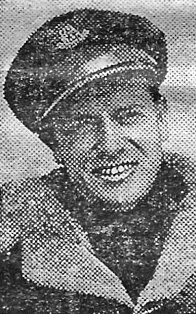
|
It appears that the enemy may intend to leave only suicidally small holding forces in the south, say in Canton and Hongkong, while he masses his major strength between the Yangtze and Amur rivers for the decisive last ditch battles on the Asiatic continent.
FEAR OF RUSSIAN INTERVENTION
One cannot rule out the likelihood that the fear of Russian intervention along the Amur figured importantly in reshaping Japan's Asiatic battle plan, but an even more demonstrable factor was the prospect that Japan's corridor to Southeast Asia could not be held open against Chinese-American offensives by land and air when they finally were mounted in force.
In that regard, the enemy's recent Chihkiang reversal at the hands of resurgent Chinese troops, tremendously aided by Chennault's Flying artillery may have had a profound effect on Japanese calculations. Such a strategy of general withdrawal would explain Japanese failure to commit their formidable reserves to that losing battle.
NEW SIXTH ARMY HELD IN RESERVE
It is noteworthy also that the Chinese won their battle without sending into action their New Sixth Army, their best trained and equipped outfit, which had been flown to the Chihkiang front in a unique American Air Transport operation.
|
When the Japanese lost their bid for the Chihkiang airbase and staging center for ground support of Chinese armies, they may have been convinced it was time to save what could be saved out of southeast China before those forces were cut off by a Chinese bisecting drive eastward, say on Hengyang.
If later developments bear out this apparent trend in Japanese strategy, it would seem that the enemy is virtually inviting the long-heralded American amphibious offensive against the southeast China coast. He may be preparing at the same time for a fight to the finish not there, with their communications extended, but rather consolidated in north China against the Americans and Chinese or possibly in Manchuria against the Russians.
JAPS WITHDRAWING INTO NORTH CHINA
Many signs point to an enemy withdrawal into a north China citadel in one of his last graspings for the initiative.
Chennault, who is not a source of other interpretive comment in this dispatch aptly phrased his immediate reaction to the Japanese abandonment of Nanning: "It looks like they think there's a three-ball alert on in Manchuria." (Three-ball alert in China airbase terminology is an urgent alarm against imminent attack.)
200,000 JAPS ABANDONED
In abandonment of Nanning, the Japanese permitted the overland door to be slammed against perhaps 200,000 troops spread over Malaya, Thailand, French Indo-China, and parts of Burma whose only hope of withdrawal to any China citadel lay in the retention of the Nanning gateway from Indo-China into Southeast China. Hundreds of American sea-sweeping planes have already forbidden any major withdrawal by sea.
At seven o'clock Saturday night, the Chinese who had driven into the town reported it deserted by the enemy. The Chinese entered in force on Sunday. The Japanese were moving north and east toward Liuchow.
Monday the first Fourteenth Air Force plane, a light liaison-type that didn't need much space, landed on the Nanning airstrip, which hadn't been repaired since the Fourteenth blew it up and burned and abandoned the base last November 19 as the last of their central line of airfields was lost to the Japanese bisection drive through Southeast China last year.
Indeed, the enemy because of his waning air power and the Fourteenth's watchful suppressive actions, never succeeded in bringing to full operational status any of 13 bases captured in Southeast China between June 24 and January 30 of this year. At most they served for fly-by-night staging stops.
INVITATION TO COAST INVASION
Thus Japan's offensive from Yochow through Changsha, Hengyang and Kweilin to link up with forces from Canton at Nanning and Liuchow was, in the light of latest development, no more than a colossal dissipation of force, although it was to be explained at the time as principally the laying of an overland supply line to Southeast Asia.
If the Japanese Southeast China withdrawal continues, it will thus amount to an invitation, not only for a landing on the China coast, but also for the recovery, one by one, of lost airbases.
Before Nanning, and other newly reported enemy withdrawals in Southeast Asia and China, amateur as well as professional strategists hereabouts thought the Japanese would fight to the last to keep the corridor there open for the retreat of their Southeast Asia troops, even if it had failed as a supply route, but this now seems to have been a loose sort of analysis.
Yet, of necessity it was this concept that inspired the bulk of American assistance to Chinese ground forces in supply, equipment, training under the U.S. Army's Chinese Combat Command which came to first fruition in the recent Chihkiang victory. By the time a full-scale Chinese offensive is possible, the Japanese may no longer be in Southeast China. Of course, they can be pursued.
ENEMY MANEUVER COMPLETE FAILURE
With the sharpened perception that often comes after the fact, it is easy to recognize the harsh military logic of the enemy's liquidation decision, which seems to been based on the conclusion that troops in Southeast Asia would be at best a battered military asset, next to worthless, when finally consolidated with other forces in China.
Moreover, the operation would have consumed precious months. Disregarding the time factor, the withdrawal to have been worthwhile, would have had to be one of those rare operations that become textbook domels of military perfection. Many hundreds of miles would have had to be covered afoot at the sacrifice of heavy equipment.
All the cards were stacked against it. Men would have perished from disease and hunger; they would have been vulnerable to flanking assaults by Chinese regulars and guerrillas, but above all, they would have been forced to undergo tremendous slaughter by air attacks.
CHENNAULTMEN FRUSTRATED JAP MOVEMENT
Any substantial movement by rail certainly by the time it reached northern Indo-China or China, would have been a sitting duck target for Chennault's fighters and bombers, even if railways could have been kept in operation which would have been close to impossible. The Japanese would have been subjected to even greater airborne punishment than is now being laid on along the Peiping-Hangkow line.
The Fourteenth Air Force's attacks on Southeast China communications, even before the Chihkiang victory, had reduced rail movements to a furtive passage of a few flange-wheeled trucks. Trucking was restricted to sneaking nocturnal operations and even then the convoys were exposed great danger from night-flying B-25 Intruders.
It has been clearly demonstrated, as the enemy undoubtedly recognized, that disaster would march with any attempt to pull out of Southeast Asia. Withdrawal from Southeast China likewise has its frightful hazards, as forthcoming communiques of the Fourteenth Air Force undoubtedly will show, but something may be saved at least.
SUPPLY SOURCE ELIMINATED
Thus the Japanese over-extension into Southeast Asia and even in Southeast China is now being turned to the Allies favor. With Nanning gone, even the trickle of supplies that once reached Southeast Asia forces has been dried up.
Their defense against the massing power of Mountbattens Southeast Asia Command will now be an autonomous one, limited by their present number with no hope of reinforcement, limited by size their stockpiles of ammunition and other supplies, limited by whatever scant means of production they have found in conquered lands.
AWAIT NEXT JAP MOVE
All this doesn't mean there is no fight left in Southeast Asia or South China, but it does mean that it is only a question of time until the delaying forces are reduced. In Southeast Asia the enemy's situation couldn't be more hopeless if Japan herself has capitulated, while in Southeast China the situation is not much brighter, although the full scope of Japan's intentions hasn't been disclosed.
Japanese psychology being what it is, one cannot eliminate the diehard possibility that the enemy may attempt a diversionary assault out of Indo-China into Yunnan Province or even an eleventh-hour attempt at walkout into Kwangsi Province, but chances are slim that, if he will try this, or that, he could succeed.
Air-Ground Liaison Tops At Chihkiang
CHUNGKING, May 31 (UP) - In the recent battle in Hunan, the air-ground liaison of the Fourteenth Air Force was developed to perfection - which was one of the major factors frustrating the Japanese onslaught toward the American airbase at Chihkiang.
The stopping of the Japanese drive in this direction was the first time throughout the past year that the fall of an American airbase under Japanese attack was prevented. During the course of last year, no less than a dozen essential American airbases in China were lost as a result of deliberate campaigns on the part of the Japanese to capture them.
U.S. AIR-GROUND LIAISON BEGAN AT CHANGTEH
Maj. Robert M. Herrick, control officer for all Fourteenth Air Force air-ground liaison teams in the Hunan area, said that the air-ground liaison - handled by members of the Fourteenth Air Force themselves - began only a year and a half ago at the battle of Changteh, west of Lake Tungting.
In this operation, the Fourteenth merely sent a few men with the Chinese forces to talk to the planes flying over the city and to direct them to the targets.
Up to last year in the battles in Burma and Kwangsi Province, the Fourteenth Air Force mainly depended upon Chinese units on the ground for directions to the targets. They also depended upon Chinese Army intelligence as to where to strafe and bomb. As intelligence message transmission was slow, those aerial attacks were not efficient.
In the April-May battle in Huna this year, the air force's own air-ground liaison teams were placed in strategic positions around the front lines. The actual number of teams cannot be revealed because of security, but there are enough teams to ensure most efficient possible strafing and bombing to make the Japs run for their lives or die.
Maj. Herrick said all teams are organized according to regulations. Each team consists of one officer, two enlisted men who are radio operators, all Americans, and one Chinese interpreter.
UP-TO-THE-MINUTE INFO ON JAP POSITIONS
Thus instead of bombing and strafing positions where the Japanese were reported 48 hours ago as was the case in the battle in Kwangsi last year, liaison teams provide reported regarding Japanese positions to the base within five minutes by radio. Planes may be over the target area within 30 minutes.
Other duties of the liaison teams include giving ground signals, and talking over radiophone to flyers in order to adjust their positions for the utmost accuracy.
The teams work in positions very close to the actual fighting lines. In one instance in the Hunan battle, the team members thought they were 80 yards from the Japanese - but suddenly found that they were only 15 yards from the enemy and suffered an attack by hand grenades.
JAP TRICKY - BUT NOT ENOUGH
To offset this organization, the Japanese gave American type signals to trick the flyers into bombing the Chinese, but that was found out before any damage was done. The Japanese were also able to use some English speaking men to try and give false directions over the radio to the planes overhead. But this was later prevented by installing American radios with a special crystal control the frequency of which the Japanese could not reach.
|
“THE AMERICAN CHINESE” -
ATC Lifts New Sixth Army Over ‘Hump’ To Chihkiang
By ALBERT RAVENHOLT
HQ., U.S. CHINESE COMBAT COMMEND, KUNMING, May 31 (UP) - The Chinese New Sixth Army, veterans of the North Burma Campaign who were ferried to China last December by the Air Transport Command, were flown into the airbase of Chihkiang for the critical Hunan battle in one of the most unique military movements of this war, Maj. Gen. Robert B. McClure, commanding the U.S. Chinese Combat Command revealed in an interview here.
Though the New Sixth Army, which was trained and equipped by Gen. Joseph W. Stilwell in India, did not fire a single shot in the critical battle for the 14th Air Force Base at Chihkiang, Gen. McClure said, they were "an ace in the hole" and the manner in which they were shifted into China and then shuttled to a critical area is significant for future operations.
CRACK 22ND DIVISION INCLUDED IN SIXTH
Gen. Liao Yao-hsiang's New Sixth Army, containing the veteran 22nd division which walked out of Burma with Gen. Stilwell in 1942 and the 14th division which was shifted by air to India for training in the spring of 1943, was rushed by transport planes from airfields in Northern Burma to bases in China to meet the critical Japanese threat to Kweiyang last winter.

|
The New Sixth Army was flown then and now again complete with horses and mules, hospital equipment and some artillery, to meet the emergency. Under the direction of American liaison officers assigned to each Chinese unit down to the regiment, working in close co-operation with ATC. Each Chinese unit was allotted a certain number of planes and lifted complete even with their kitchens back over the "Hump" to their homeland which some had not seen since they began the long march to Burma in January of 1942.
The victory at Chihkiang, Gen. McClure emphasized, was won by regular Chinese troops of Gen. Wah Yao-wu's Field Army, most of whom had been regularly stationed in Yunnan Province. They were supported by the troops of Gen. Tao En-po and supplied in a large measure by the American Army, especially during their critical counter-attack.
CCC TRAINED AND EQUIPPED
U.S. liaison officers and men of the Chinese Combat Command, the American ground army command which is set up as a parallel organization to the Chinese armies south of the Yangtze River, have been training and equipping these Chinese troops in Hunan Province for six months.
When the Japanese drive began these Americans went into action in the field and advised their respective Chinese commanders on tactics.
The General stated this, perhaps the first movement of a complete ground army by air had a very definite effect upon the tide of battle. The Japanese were unwilling to commit their limited reserve if there was no assurance of being able to destroy one of the best single armed forces in China.
When the civilians of the Chihkiang area saw the soldiers of the New Sixth Army, many of whom are natives of Hunan Province, landing and moving in behind the front they almost immediately turned and trudged back towards their homes.
The peasants called the cocky, well-fed, helmeted soldiers of the New Sixth Army who contrasted so sharply to the under-nourished troops they were accustomed to "The American-Chinese."
The New Sixth Army Gen. McClure concluded, remains fresh and available for an offensive as any other units of similar type.
CHINESE GUERRILLAS HAMPER -
Japs Struggling To Secure Grip On Corridor In Hunan
By GEORGE WANG
CHUNGKING, May 31 (UP) - After touring areas in Japan's continental corridor in Hunan Province, I have obtained reliable information that the Japanese are strengthening their garrisons there, attempting a desperate grip on the corridor against:
1.) Constant attacks by the Fourteenth Air Force.
2.) Constant raids by Chinese guerrillas dispatched and supplied regularly by the Chinese Army.
3.) A potential Chinese attack on the Hunan and Kwansi sections of the corridor by the newly victorious Chinese field forces which are eager to continue their fight to cut Japan's mainland lifeline.
JAP ENGINEER REINFORCEMENTS REPAIR BRIDGES
I received information that the Japanese have reinforced their engineering units along the corridor to repair bridges and other installations which are constantly being destroyed by the Fourteenth Air Force. These units are from less-threatened parts of occupied China such as the lower Yangtse. They have now been moved to guard bridges and locomotives.
It is a well-known fact that the Japanese are able to repair a damaged bridge overnight and a destroyed bridge in a couple of days. Engineering units are also busy repairing damaged locomotives. However, destroyed locomotives are usually quickly removed to Japanese arsenals to be used as scrap iron.
ROUND-THE-CLOCK U.S. AIR RAIDS
The Fourteenth Air Force is raiding the corridor both day and night and even on moonless nights. Flyers report they see no movement along the highways and railways of the corridor during the daytime. Because of their harassing sorties, the corridor in the daytime appears deserted.
Guerrillas placed along the corridor by the Central government provide the main threat to the enemy's lifeline at
|
They always move after dark and get advance information concerning oncoming Japanese truck convoys, which sometimes consist of as many as 60 to 100 trucks. For every three Jap supply trucks there is one truckload of escorting troops.
The guerrillas place themselves at a strategic point along the route and as soon as the convoy arrives they hit the leading truck in order to halt the whole convoy. Sometimes the ensuing battle may last as long as two hours and 200 Japs may be killed. The battle may end with the convoy and supplies being captured as the Japanese flee.
CHINESE GUERRILLAS ACTIVE EVERY NIGHT
These scores of guerrilla squads placed along the corridor zone in Hunan Province make such raids every night and sleep only after 5 a.m. and following lunch. After that they tune in their portable battery radio sets to get broadcasts from San Francisco, New Delhi and Chungking.
After seriously defeating the Japs in the recent Hunan battle, the victorious Chinese forces are fully prepared and obviously capable to chase the Japanese to Paoching.
If and when the corridor is cut in two, the long Japanese serpent with its head in Manchuria and tail in Singapore will be cut in the waist.
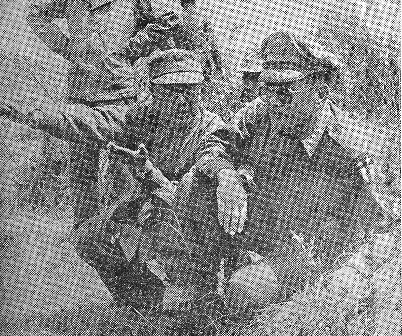 GENERAL CONVERSATION - Lt.-Gen. Liao-hsiang, commanding general of the New Chinese Sixth Army, explains a tactical maneuver to
Maj.-Gen. R. B. McClure, commanding general U.S. CCC, during a training demonstration by Chinese troops at an installation somewhere in
Free China. (Signal Corps photo).
GENERAL CONVERSATION - Lt.-Gen. Liao-hsiang, commanding general of the New Chinese Sixth Army, explains a tactical maneuver to
Maj.-Gen. R. B. McClure, commanding general U.S. CCC, during a training demonstration by Chinese troops at an installation somewhere in
Free China. (Signal Corps photo).
|
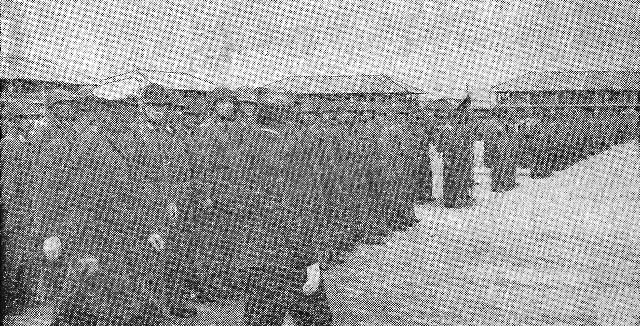 TROOPS AND EQUIPMENT - of the New Sixth Chinese Army being reviewed by Maj.-Gen. R. B. McClure, Lt.-Gen. Liao Lao-hsiang and Col.
W. C. Phillips. (Signal Corps photo).
TROOPS AND EQUIPMENT - of the New Sixth Chinese Army being reviewed by Maj.-Gen. R. B. McClure, Lt.-Gen. Liao Lao-hsiang and Col.
W. C. Phillips. (Signal Corps photo).
|
|
U.S. RIFLES TO REPLACE ‘CAVE WEAPONS’
USED ON CHIHKIANG FRONT
CHUNGKING, May 31 (UP) - According to information from the Hunan front, native-made Chinese rifles, generally known as "Generalissimo rifles" in large numbers played a major part in defeating the Jap drive toward the American Air Force base at Chihkiang. "Generalissimo rifles," produced in mountain cave-arsenals in west China are the favorite weapon of the Chinese soldiers.
American Thompson light machine-guns, which are distributed in smaller numbers than the "Generalissimo rifles" are also favorites of the Chinese on the Hunan front.
The U.S. Chinese Combat Command is engaged in a busy program of training and re-equipping the Chinese forces and will soon equip every individual Chinese soldier with American rifles of a type more efficient than the "Generalissimo rifles," and a larger number of Thompsons will be delivered to the Chinese forces.
In future battles on China's mainland, the Japs will be confronted with weapons much more powerful than the "Generalissimo rifles" which defeated them this time.
GI Trucks Rolling Into Free China
CHUNGKING, May 31 (UP) - New 6 x 6 trucks, weapons carriers, trailers and jeeps, over a thousand in number, have been brought in over the Stilwell Road since its opening last January 19. They have reached all parts of free China, burning American gasoline which is constantly flowing in via the world's longest pipeline - the India-China pipeline. While the exact four-figure number of new American vehicles brought in over the Road during the past four months and one week cannot be revealed, it may be said that the total number brought in thus far already exceeds the total number of "useable" motor vehicles Free China had during her blockaded days.
TWO TYPES OF TRUCKS IN CHINA NOW
Everywhere in Free China one sees two entirely different kinds of trucks. Old, obsolete, pre-Pearl Harbor trucks, installed with charcoal burners and alcohol burners, usually breaking down every few miles along China's zigzag mountain roads, overloaded, coughing and droning loudly like an old horse carrying 200 pounds uphill. They give Chinese mechanics and drivers constant trouble and require hourly repair on the roads.
The other kind are the new American trucks, strong, tough, never overloaded and seldom breaking down and very often driven by GIs because the training of Chinese drivers is not fast enough to handle the ever-increasing number of new vehicles.
NEW TRUCKS NORTH OF YANGTSE RIVER
An American general in China recently pointed to the Tungting Lake area on a map when asked how far the new trucks reached in south China. The minister of Communications, Lt. Gen. Yu-feipeng, in Chungking announced that a "small portion of the first allotment of new trucks has actually been received in the northwest," referring to the north-western provinces of Free China far north of the Yangtse River.
A number of the new trucks have already made their usefulness felt in the April-May battle in west Hunan. Driving along the scenic roads beside Hunan's placid rivers and pine-covered mountains, the new trucks rushed weapons, ammunition and gasoline to front-line troops and brought back wounded men on return journeys. The GIs driving these vehicles make it a rule to return the salute with the right thumb up of the Chinese peasants saying "ding hao."
|
FIRST TIME IN CHINA -
GI Portable Field Hospitals
Aid Chinese On Hunan Front
CHUNGKING, May 31 (UP) - For the first time in China, American portable field hospitals were put into full operation on the Hunan front with American GIs evacuating Chinese wounded from the battle lines in American trucks.
Col. Paul G. Hansen, Cleveland, Ohio, surgeon in command of three portable surgical hospitals has divided the units into six stations operating at different locations behind the lines, providing soldiers with the best medical care in eight years of China's war.
AMMO UP - WOUNDED SOLDIERS REARWARD
GIs operating with the units are doing dual service, hauling ammunition forward in jeeps, weapons carriers, 6 x 6 trucks and trailers and removing the wounded to the rear on the return journeys.
From the start of the Japanese drive on the Hunan front, roughly 50 days ago to the present, at least 5,000 wounded have been evacuated by trucks to field hospitals. Some GIs who never drove trucks before took over the task after only 30 minutes training and did the job well, wheeling heavy vehicles over zigzag roads through 5,000 foot mountains without an accident.
NEW TRUCKS BEING USED
One morning ten 6 x 6 trucks loaded approximately 300 wounded men at a portable hospital to be taken rearward for better care. Minor wounds and some serious cases waited perhaps half an hour before the trucks passed. GIs helped to carry stretchers for litter cases. The wounded, going rearward, all seemed happy and confident of the American medical aid. In teahouses on the front, Chinese soldiers are heard saying "we have American doctors, hospitals, medicines, and American soldiers helping to evacuate the wounded."
The trucks employed on the Hunan front are new to China since they were recently brought in over the Stilwell Road. This means that the impact of the Stilwell Road is already being felt on the Hunan front.
|
|
Oklahoma Bows Out With Benefit Shows
KUNMING - In a fitting gesture of Chinese-American friendship, one of the two final performances of "Oklahoma," the musical hit which has enchanted as well as entertained thousands of GIs in this area, was given last Thursday night before a packed Chinese audience at the Nanping Theater in Kunming for the benefit of the Chinese Soldiers' Field Hospital and Kunming Orphanage.
It was a gala as well as purposeful evening, with an appreciative first night audience composed of prominent Chinese civic and military representatives, as well as other Allied dignitaries. Although most of the audience through the movies are familiar with American musicals, this was the first "live" song-and-dance show for them. The colorful Westerner costumes were particularly impressive to them.
The two benefit performances were sponsored by the Kunming Women's Organization, under the chairmanship of Madame Yun Lung, wife of General Yun Lung, governor of Yunnan Province.
With the benefit tickets prices scaled at 1000, 2000 and 3000 CN each, the proceeds for the orphanage and hospital are estimated to be about 4,000,000 CN for the two nights' stand.
Last Friday, May 25, was the final performance of the Base Special Service production of "Oklahoma." Originally scheduled for two performances at the Hangar Playhouse, its cast and staff of 50 persons, all volunteers from 15 organizations in China have played 21 "encore" performances.
Success Of Oklahoma Prompts More Shows
AIR BASE, APO 627 - Entertainment hungry soldiers in the Air Base, APO 627 soon will be served more solid theatrical fare, the Base Special Service, Entertainment Unit, announced with two long-run Broadway comedy hits set for production.
First on the schedule is "Room Service," a farce whose success was proven with a two-year Broadway run and two movies adapted from it. It is a three-act comedy concerning a playwright in search of a producer. Auditions for parts for interested actors and actresses were scheduled for Monday and Tuesday nights, 7:30, May 28 and 29 at the Base Special Service library, but those with experience may still audition for several openings.
Second laugh hit,, to follow "Room Service," will be "The Man Who Came To Dinner," authored by George S. Kaufman and Moss Hart especially for the late Alexander Woolcott, nationally loved writer and raconteur. Tryouts for "The Man" were held the same time as for "Room Service."
Opening date for "Room Service" is set for late June.
Red Cross Opens New
EM Club At Kweiyang
KWEIYANG, CHINA - The American Red Cross opened a new club here which GI visitors this week described as one of the most beautiful and best equipped in the China-Burma-India area.
Brig.-Gen. Frederic W. Boye, commanding general of the Central Command, Chinese Combat Command, officially turned the new club over to enlisted men at a formal ceremony Thursday, May 10. S/Sgt. Emil William Frandsen, Groton-on-the-Hudson, N.Y., chairman of the club's Enlisted Men's Committee accepted the key to the club from Gen. Boye.
Comprising three large buildings and as many landscaped courtyards, the club's attractions will include a 25-bed hostel for use by soldiers in Kweiyang on passes from outlying areas.
Also promising to win favor are the club's six equipped photographic darkrooms, lounge rooms, library, snack bar and craftsmanship studio.
Miss Flora Coutts, of Newport, Vt., who headed similar clubs in India and at Kunming, is the club director. Other staff members are Mrs. Esther Conlin, of Rochester, N.Y., assistant director; Mrs. Gladys Wavrek, of Harrisburg, Pa., program director; and Miss Betty Quick, of Watertown, N.Y., staff assistant. Twenty Chinese girls are acting as hostesses.
The club was first opened to visitors Sunday, May 6, although the extensive remodeling operations were still incomplete. Officers were invited to inspect the club during the first five days but after the formal opening the unit was reserved exclusively for enlisted men.
|
CHUNGKING, May 31 - The new American Red Cross club for the enlisted men of the Chungking area opened its doors recently to a crowd of enthusiastic GIs who took one look at its spacious lounge, its game rooms and its snack bar, and promptly dubbed it strictly stateside.
Brig.-Gen. Mervin E. Gross, acting chief of staff to Lt.-Gen. A. C. Wedemeyer, figuratively threw out the first doughnut, presenting the club to service personnel of the China Theater on behalf of Gen. Wedemeyer. Gen. Wedemeyer also sent two gifts for the new club, a leather-bound guest registration book and a Chinese scroll.
Miss Mimi Buescher, Columbia, Mo., Red Cross staff assistant, arranged a dedicatory program which included everything from Gen. Gross's speech to free ice cream and cake and an extensive collection of first class entertainment.
Pvt. Alexander F. Korotsky, Jamaica, L.I., M.C.'d the program. Miss Jean Bowyer, Abilene, Tex., of the Red Cross, gave the new club a name, and the club director, Mrs. Naomi Thompson of Washington, Pa., thanked everybody for their aid in the construction of the new club - located in the Chiu Ching Middle School - and threw in an extra plug for the Air Transport Command, which brought in a lot of necessary materials.
Sgt. Paul Schommer, Chadron, Neb., and S/Sgt. Milford Phillips, Baltimore, Md., stopped the show with a jitterbug number, with Schommer dressed as a country belle, with all accessories. The Ambassadors, a 12-man glee club led by Pfc. Joseph Leinigar, Cleveland, Ohio, presented fifteen minutes of harmony, and Tony Apicella and his orchestra furnished the musical background for the evening, tossing in a couple of top-flight numbers of their own.
Sgt. Schommer and Chief Yeoman Jimmie (cx) Swoard of Jacksonville, Fla., representing the enlisted men of the Army and the Navy, accepted the registration book and scroll from Gen. Gross. Sgt. Charles Blair, Janesville, Wis.,; Pfc. Leonard Upham of Providence, R.I. and PhM1c Ansel Smith of Denver, Colo., took part in skits presented during the program.
|
|
|
Four Track Marks Shattered
At Inter-Allied Cinder Meet
KUNMING - Battering four former track and field records under ideal weather conditions, the American team piled up a total of 74½ points to 14½ for the Chinese cinder men, to sweep the second annual Chinese-American Track Meet last Sunday, May 27, at the Yunnan Provincial Stadium.
Military necessity prevented the appearance of a considerable number of the Chinese Army entrants leading to the lopsided American triumph, in sharp contrast to last year's meet which was close all the way and only the Americans superiority in the field events led to the margin of victory.
Despite the fact that the Inter-Allied meet drew only a small contingent of Chinese competitors, the spectators were rewarded with some stellar performances as the track marks for the 220 yard dash, 880 yard run, the broad jump and the discus throw were shattered during the afternoon's events.
Pfc. Duane Paulsgrove forged ahead in a blanket finish in the 220 yard sprint to set a new mark of 23.7 seconds for the distance; Pfc. John Lynch retained his half mile crown and lowered the mark four seconds by galloping over the distance in 1:65.1; Capt. Dick Ganslen jumped 20 feet 11 3/4 inches in the broad jump, and Capt. Melvin M. Sylvan, former Univ. of Mich. discus star, making his first appearance in the China meet, hurled the platter 144 feet 1 inch for the other field mark.
Pfc. Lewis Bass, ATC workhorse who places consistently in the sprint events, runs the relays and competes in the broad jump, tied the 100 yard dash mark of 10.6 seconds set two weeks ago by his teammate Pfc. Arvein Goodman, and the American 440 yard relay team the old standard of 49 seconds for that event.
POLE VAULT: Capt. Dick Ganslen (Am) 12'6"; C. P. Wei (Ch) 10'9"; Pfc. Robert Rhodes (Am) 10'6".
HIGH JUMP: Lt. William Taylor (Am) 5'9¾"; Pfc. Robert Rhodes (Am) 5'5"; C. P. Wei (Ch) and Pvt. Calvin Harsh (Am) tied for third at 5'2".
SHOT PUT: W/O Joseph Bressler (Am) 49'6"; Pfc. Jack Abeltin (Am) 47'3½"; Capt. Melvin Sylban (Am) 47'.
ONE MILE RUN: Pfc. Jon Lynch (Am) 5:09.1; T. K. Lee (Ch) second; T. H. Wang (Ch) third.
440 YARD RUN: Lt. William Wyatt (Am) 57.8; Corp Irving Wood (Am) second; Sgt. Donald Stratton (Am) third.
100 YARD DASH: Pfc. Lewis Bass (Am) 10.6; Pvt. Arveln Goodman (Am) second; Pfc. Duane Paulsgrove (Am) third.
800 YARD RUN: Pfc. John Lynch (Am) 2:05.1*; Pfc. Francis Ferro (Am) second; S. K. Lee (Ch) third.
DISCUS THROW: Capt. Melvin Sylvan (am) 144'1"*; W/O Joseph Bressler (Am) 142'8"; S/Sgt. Mel Maceau (Am) 124'7".
220 YARD DASH: Pfc. Duane Paulsgrove (Am) 23.7*; Pfc. Lewis Bass (Am) second; Sgt. R. Spradling (Am) third.
BROAD JUMP: Capt. Dick Ganslen (Am) 20'11¾"; Jimmy Mao (Ch) 20'9"; Capt. Albert Parr (Am) 19'6".
440 YARD SPRINT RELAY: Won by the American team of Pfc. Duane Paulsgrove, Pfc. John Discepolo, Pfc. Henry Carroll and Pfc. Lewis Bass. Time: 49"
*New Record - Sgt. Lewis Leong
Signal Ten Socks ‘Brass Hats’ 20-4
Scattering 16 hits to all corners of the diamond, the Signaleers trounced the General Staff School ten 20-4 Saturday afternoon at the losers field, to win the first of a three-game series for the APO 627 SOS softball championship.
The Signaleers built up a 16-0 lead going into the last half of the sixth inning before the 'brass' aggregation could solve the slants of 'Fireball' Phil Knight, and combined six hits in the last two stanzas for four runs.
Gene Claxton was the big stick for the Signaleers, belting a double, triple and a home run to drive seven runs across the plate and score four times himself. Schor, General Staffer second-sacker, led the losers with two hits.
The two teams will meet in the second game of the series on Saturday afternoon, June 2.
ASC Officer Ten Wins Area Title
A walk, a hit and a bad throw were the story of the ball game Saturday as the ASC Officers topped the 14th AF Hq. EM in the finals of the inter-league playoffs, 2-0, to win the Kunming area softball championship
All the scoring for the game was done by the ASC Officers in the top half of the first inning as Yerman walked, Slovacek pushed a bunt past Alderman, the EM first sacker, who came rushing in, for a double scoring Yerman, and then scored himself as the first baseman threw wildly past third in an effort to prevent his advancing.
Stravas, the EM pitcher, hurled nice ball the rest of the way, giving only five hits and no runs, but his mates were helpless before the slants of Behrens, the brass' chucker, who gave only one hit - to Buffa, who bunted safely in the first inning - fanned 15, and didn't allow an EM past second base over the seven inning route.
The game was the final of the playoffs between six league champions, and was the culmination of the season in which 54 teams played through the various schedules. The ASC Officers had won the International League, and the 14th AF Hq. EM were the champs of the National League. A trophy emblematic of the Kunming area championship was presented to the winners by Maj.-Gen. C. L. Chennault, commanding general of the 14th Air Force.
Trotters Lead In West China League
AN ADVANCED AIR BASE, CHINA - The "Globe Trotters" swept into the league lead on May 23 as they clipped the wings of the "Flying Ack-Ack" nine with a decisive 12-2 pummeling in the feature game of the week in the West China Baseball loop.
S/Sgt. Hal Peters, "Globe Trotters" moundsman, not only pitched his fourth consecutive league victory but also hammered out three hits to insure his own win. S/Sgt. Henry, "Trotters" keystone man, had a perfect day at the plate with two doubles and three singles to lead the 19-hit battering of the "Ack-Ack" chuckers.
The "Ack-Acks" drew first blood with a run in the first inning, but after that it was no contest as the Globe Trotters scored two runs in the second, three in the third, two more in the fifth and added four in the sixth.
Bulldogs & CCC Lead Pack In Kunming Baseball Circuit
The SOS and CCC stayed at the top of the American Baseball League Sunday as the Bulldogs topped the Rinkdinks 9-7 at the Post Office Field, the Club 11 nine battered the Mustangs 21-4 and the CTC Snipers edged out the Yankees 6-5 at the Kunming Athletic Field.
The Club 11 team had a field day at the plate as they scored eight runs in the opening inning and five more in the second to ice the game at the end of two innings. The CCC club used practically their whole lineup in the 20-hit assault on Worsham and Robinette, the Mustang hurlers. Chiarette with six for four, and Wachtell with five for three led the Club 11 outfit in the batting average-fattening afternoon. Hughes, the CCC pitcher, held the Mustangs scoreless for five innings, in addition to getting three hits, before he retired with the easy win in his pocket.
WEISS WON
In the other game at the Kunming field, Vic Weiss, CTC Snipers centerfielder, practically won the game singlehandedly, as his club scored their first win of the league schedule, topping the China Yankees 6-5. In addition to belting out three solid hits in three official appearances, Weiss covered the centerfield area like a blanket, making four sensational catches and two brilliant throws to nip Yankee runners on the basepaths.
Clinton, the Snipers second-sacker was another big factor in the win, contributing a homer in the fifth and a triple in the seventh to the run-making department, and coming in to pitch in the eighth inning to stem a Yankee rally that threatened to tie the score.
UNPOPULAR DECISION
Ralph Ihde, Yankees catcher, led the losers with three hits in four times at the dish. Palumbo, Yankees hurler, scattered 13 hits over the nine inning route and nearly knotted the score in the eighth, when he was cut down at the plate, in what was far from a popular decision.
Successive hits by Brown, Wilson and Staley, combined with a hit batsman and two Rinkydink errors after two were out in the fifth inning, scored six runs and was the big inning which sent the Bulldogs on to best the Air Base 9-7 at the Post Office field.
HARDY FIELDS
Up to that time Wilkins, the Rinkydinks hurler, had held the SOS club to two hits and one unearned run and was ahead 3-1, but that single bad inning gave the Bulldogs a lead they never relinquished. For the first time this season Hardy, the Bulldogs pitcher, was hit freely, but scattered 11 Rinkydink hits over the route and cut down the dangerous rallies.
The Rinkydinks threatened in the ninth when Purcell singled off the pitchers glove and Richards slammed a home run deep into left field with one away, but Hardy forced Bill to ground to third base and fanned Wilkins to end the game.
Base Mitt Matches Thursday, June 4
AIR BASE, KUNMING - With all accommodations arranged for both the competitors and spectators, and only the final matching to be done, there are still openings to enlarge the card for the air base fight festival Thursday, June 7, it was announced this week from the Base Special Service Office.
"Competition is open to everyone, and all members of the armed forces are welcome to compete," reminded Maj. Mark Conn, Base Special Service Officer, and added that entries for this card close on Monday, June 4.
Special emphasis was laid on the fact that all fighters will be evenly matched, with the three two-minute rounds governed by modified National Collegiate rules, and competent third men in the ring.
Many of the boxers from the previous cards at the 'Hangar' have entered next Thursday's mitt carnival vying for the individual prizes for all winners, and the trophy for the outstanding boxer of the evening, assuring a top-notch evening of bouts.

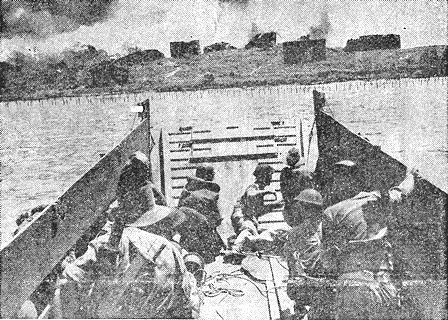 BLOCKADES AHEAD - Australian soldiers are ready to wade ashore on Island of Sadau. Invasion precedes larger operations at Tarakan,
6 miles to the southeast. Iron rails in water were placed there by Dutch in 1942 as protection against Jap invasion. Aussie engineers
later removed them.
BLOCKADES AHEAD - Australian soldiers are ready to wade ashore on Island of Sadau. Invasion precedes larger operations at Tarakan,
6 miles to the southeast. Iron rails in water were placed there by Dutch in 1942 as protection against Jap invasion. Aussie engineers
later removed them.
|
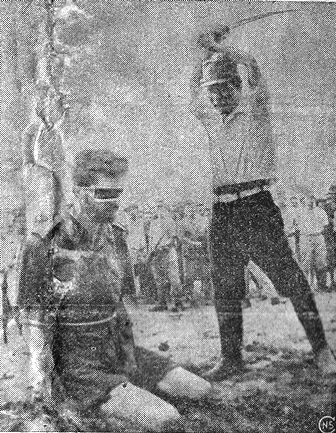 EXECUTION JAP STYLE - Photo obtained by "Life" Magazine, is said to have been taken by a Jap of a Jap officer who is about to behead
an Allied serviceman with his samuri sword.
EXECUTION JAP STYLE - Photo obtained by "Life" Magazine, is said to have been taken by a Jap of a Jap officer who is about to behead
an Allied serviceman with his samuri sword.
|
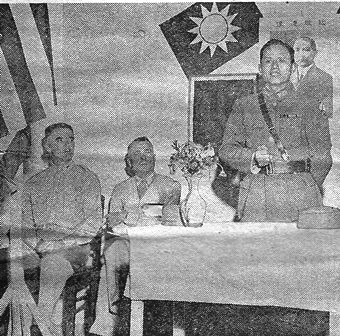 MAJ.-GEN. LIANG HWA-SHENG, commandant of the Yunnan Training Command, addressing the graduates of the Infantry Training Center which
is operated by the U.S. Chinese Training Command. Looking on is Lt.-Col. Harold W. Simmons, left, and Col. Mose Kent, center, ITC commandant,
who also spoke to the graduating Chinese Army officers. (Signal Corps Photo) See story above
MAJ.-GEN. LIANG HWA-SHENG, commandant of the Yunnan Training Command, addressing the graduates of the Infantry Training Center which
is operated by the U.S. Chinese Training Command. Looking on is Lt.-Col. Harold W. Simmons, left, and Col. Mose Kent, center, ITC commandant,
who also spoke to the graduating Chinese Army officers. (Signal Corps Photo) See story above
|
 CHINESE BABY, oblivious to the cares of a war-torn people, slumbers peacefully in his ragged blanket coat in a homemade bamboo
carriage. (Signal Corps photo)
CHINESE BABY, oblivious to the cares of a war-torn people, slumbers peacefully in his ragged blanket coat in a homemade bamboo
carriage. (Signal Corps photo)
|
 CHOSEN as a typical modern girl of the Golden West, Toni Atwater poses with her favorite mount at Las Vegas, Nev. When not riding
the range the comely equistrienne holds down riveting job in plane plant. Her husband, Capt. John Atwater, is stationed in Dutch East Indies.
CHOSEN as a typical modern girl of the Golden West, Toni Atwater poses with her favorite mount at Las Vegas, Nev. When not riding
the range the comely equistrienne holds down riveting job in plane plant. Her husband, Capt. John Atwater, is stationed in Dutch East Indies.
|
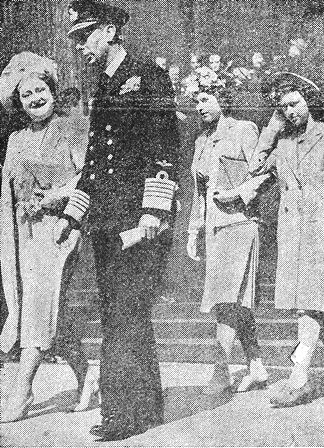 ROYAL FAMILY - King George of England and Queen Elizabeth are shown as they leave St. Paul's Cathedral in London after attending
Sunday services. They are followed by their daughters, Princess Elizabeth and Margaret Rose.
ROYAL FAMILY - King George of England and Queen Elizabeth are shown as they leave St. Paul's Cathedral in London after attending
Sunday services. They are followed by their daughters, Princess Elizabeth and Margaret Rose.
|
 FUEHRER NUMBER TWO, Adm. Karl Doenitz leaves the headquarters of the vanquished German High Command at Flensburg. The self-appointed
successor to Adolph Hitler changed the theme of the former dictator's policies.
FUEHRER NUMBER TWO, Adm. Karl Doenitz leaves the headquarters of the vanquished German High Command at Flensburg. The self-appointed
successor to Adolph Hitler changed the theme of the former dictator's policies.
|
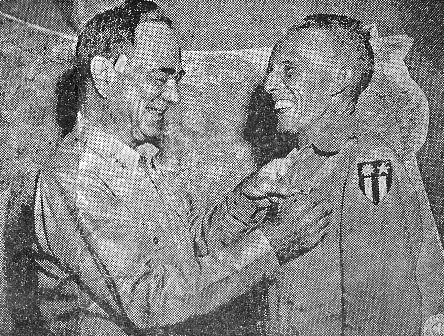 BRIG.-GEN. JOHN M. THOMPSON, right, recently assigned to the China Theater, receiving the Oak Leaf Cluster to the Legion of Merit from
Lt.-Gen. Dan I. Sultan, commanding general of IBT, for his work as assistant chief of staff, G-4, of IB. The citation read, in part, that
Gen. Thompson "by the exercise of initiative, sound judgement and tact secured the co-operation of all supply agencies in working toward a
common goal, thus keeping vital materials of war flowing to the field forces in China and Burma." (Signal Corps photo)
BRIG.-GEN. JOHN M. THOMPSON, right, recently assigned to the China Theater, receiving the Oak Leaf Cluster to the Legion of Merit from
Lt.-Gen. Dan I. Sultan, commanding general of IBT, for his work as assistant chief of staff, G-4, of IB. The citation read, in part, that
Gen. Thompson "by the exercise of initiative, sound judgement and tact secured the co-operation of all supply agencies in working toward a
common goal, thus keeping vital materials of war flowing to the field forces in China and Burma." (Signal Corps photo)
|
The CHINA LANTERN is the newspaper for the United States Forces in the China Theatre and is published three times weekly by Lt. Lester H. Geiss, Editor-in-Chief, for military personnel only. Lt. Harry D. Purcell, Managing Editor; Lt. Maurice Pernod, Production Chief. Pfc. Richard P. Wilson, Reporter. Editorial offices: Hqrs., SOS China Theater, Kunming, China, and Hqrs., SOS, Calcutta, India. Printed by Ajit Kumar Sinha at the "Amrita Bazar Patrika" Press, Calcutta. Unless specifically stated, news and features appearing in the China Lantern do not necessarily represent the views of the War Department; the Commanding General, USF, CT, or any other official source.

JUNE 1, 1945
Adapted from the original issue of The China Lantern
Copyright © 2019 Carl Warren Weidenburner
TOP OF PAGE PRINT THIS PAGE ABOUT THIS PAGE
SEND COMMENTS CLOSE THIS WINDOW
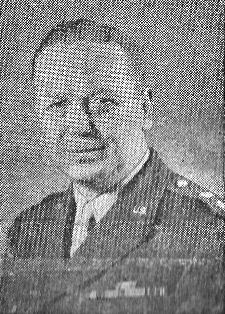
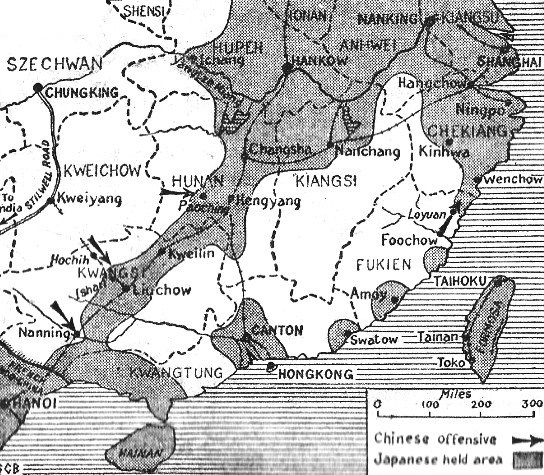
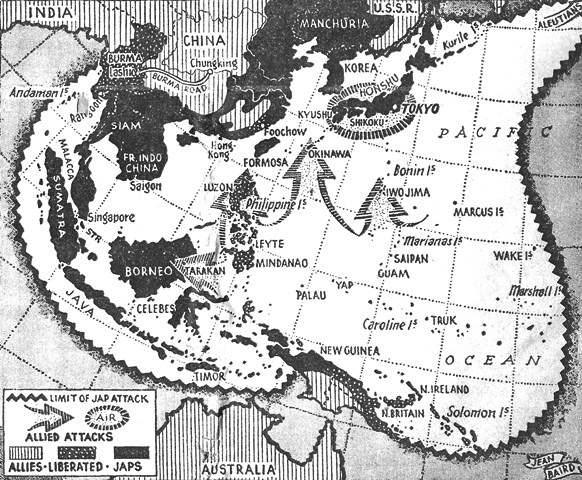

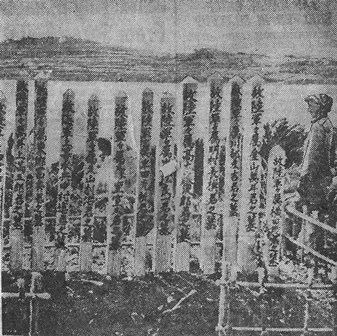 GOOD JAPS - An American soldier stands outside a small fence-enclosed Japanese cemetery on Okinawa, in the Ryukyus, where a few of the
thousands of the enemy who have lost their lives in the struggle for the strategic island are buried. Names of the dead are written in Japanese
on wooden pillars. In the background, Seoska Shima, neighboring island, burns after shelling by U.S. warships. (Radiophoto.)
GOOD JAPS - An American soldier stands outside a small fence-enclosed Japanese cemetery on Okinawa, in the Ryukyus, where a few of the
thousands of the enemy who have lost their lives in the struggle for the strategic island are buried. Names of the dead are written in Japanese
on wooden pillars. In the background, Seoska Shima, neighboring island, burns after shelling by U.S. warships. (Radiophoto.)
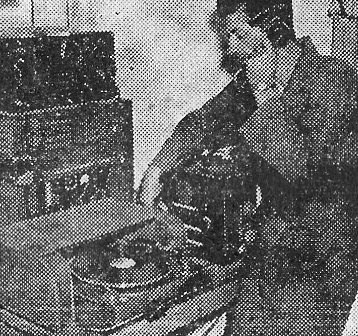
 Pfc. Jack S. Castiglia, right, Chicago, explains the operation of the short-wave diathermy machine he constructed to Col. Alexsei A.
Leonidol, Poughkeepsie, N.Y., commanding officer of the hospital, and Lt. Joan Landers, Waban, Mass. (Signal Corps photo).
Pfc. Jack S. Castiglia, right, Chicago, explains the operation of the short-wave diathermy machine he constructed to Col. Alexsei A.
Leonidol, Poughkeepsie, N.Y., commanding officer of the hospital, and Lt. Joan Landers, Waban, Mass. (Signal Corps photo).
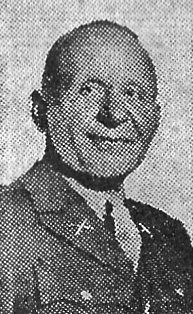
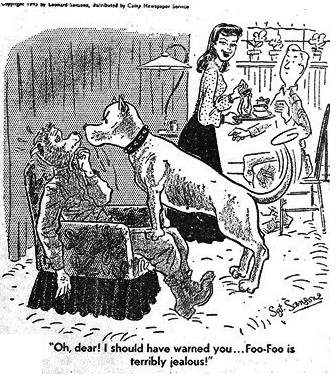
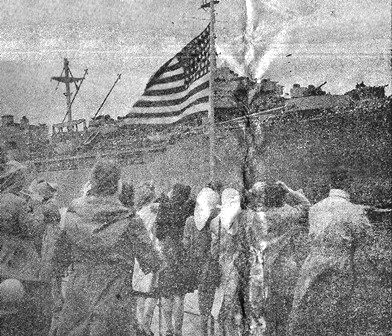 WELCOME HOME - As first convoy ship from Europe since V-Day steams into pier at Staten Island, WAC band plays and civilians wave from
"Welcome Home" boat in harbor. Yanks crowd rails on P-132 convoy vessel for glimpse of American flag and to wave greetings.
WELCOME HOME - As first convoy ship from Europe since V-Day steams into pier at Staten Island, WAC band plays and civilians wave from
"Welcome Home" boat in harbor. Yanks crowd rails on P-132 convoy vessel for glimpse of American flag and to wave greetings.
 "If you'll turn my weapons platoon loose, I'll give ya my cooks for security. I'm goin' on th' line tonight."
"If you'll turn my weapons platoon loose, I'll give ya my cooks for security. I'm goin' on th' line tonight."
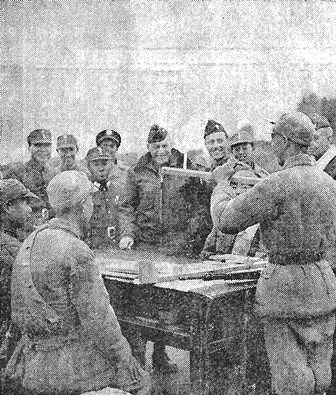 RIFLE SIGHTING is an integral part of training for Chinese troops as it is for American troops. Brig.-Gen. Henry A. Barber, Jr., deputy
commander of the Chinese Combat Command smiles encouragingly upon a Chinese soldier learning marksmanship with the aid of a sighting device.
(Signal Corps photo).
RIFLE SIGHTING is an integral part of training for Chinese troops as it is for American troops. Brig.-Gen. Henry A. Barber, Jr., deputy
commander of the Chinese Combat Command smiles encouragingly upon a Chinese soldier learning marksmanship with the aid of a sighting device.
(Signal Corps photo).
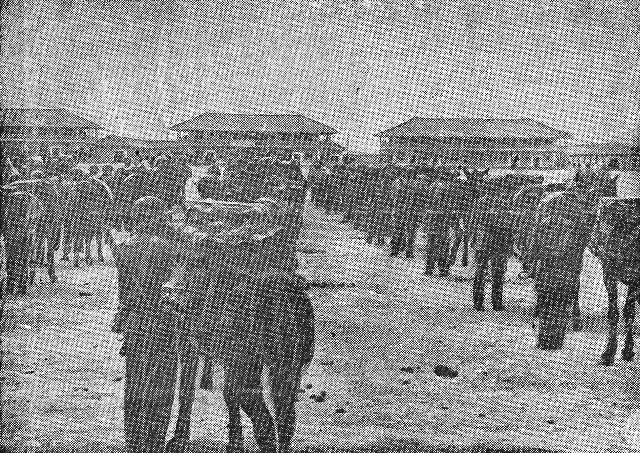 A NEW SIXTH ARMY installation being inspected by a party which includes Maj.-Gen. R. B. McClure, commanding general US CCC;
Lt.-Gen. Liao Yao-hsiang, commanding general of the New Sixth, and Col. Walter C. Phillips, commanding officer of a U.S. Combat section
of the CCC. (Signal Corps photo).
A NEW SIXTH ARMY installation being inspected by a party which includes Maj.-Gen. R. B. McClure, commanding general US CCC;
Lt.-Gen. Liao Yao-hsiang, commanding general of the New Sixth, and Col. Walter C. Phillips, commanding officer of a U.S. Combat section
of the CCC. (Signal Corps photo).
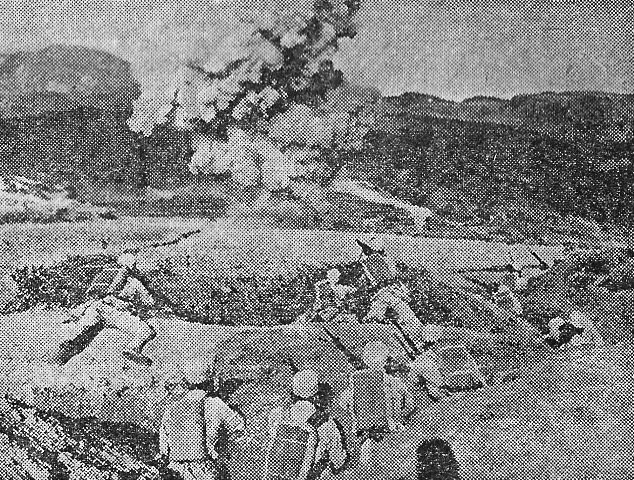 WELL SUPPLIED, WELL TRAINED, Chinese are on the offensive again. This picture shows Chinese troops crouched in a trench along the
Salween River front in southern Yunnan Province where they hurled back a Japanese offensive. (Signal Corps photo).
WELL SUPPLIED, WELL TRAINED, Chinese are on the offensive again. This picture shows Chinese troops crouched in a trench along the
Salween River front in southern Yunnan Province where they hurled back a Japanese offensive. (Signal Corps photo).
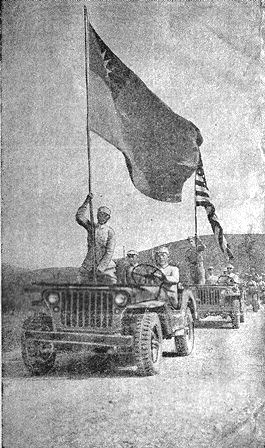 ON THE MARCH AGAIN - Sino-American co-operation was demonstrated late last year in the successful Salween campaign to reopen the Burma Road.
Flags of both nations led the procession in Lungling, ancient city on the Road from which the Japs were driven by Chinese troops.
Now these proud symbols of democracy are on the march again in China. (Signal Corps photo).
ON THE MARCH AGAIN - Sino-American co-operation was demonstrated late last year in the successful Salween campaign to reopen the Burma Road.
Flags of both nations led the procession in Lungling, ancient city on the Road from which the Japs were driven by Chinese troops.
Now these proud symbols of democracy are on the march again in China. (Signal Corps photo).
 PHYSICALLY FIT, and to prove it these troops of a Chinese division recently put on an exhibition for Gen. Ho Ying-chin, supreme
commander of all Chinese Armies, and Maj.-Gen. R. B. McClure, commanding general of the U.S. Chinese Combat Command. (Signal Corps photo).
PHYSICALLY FIT, and to prove it these troops of a Chinese division recently put on an exhibition for Gen. Ho Ying-chin, supreme
commander of all Chinese Armies, and Maj.-Gen. R. B. McClure, commanding general of the U.S. Chinese Combat Command. (Signal Corps photo).

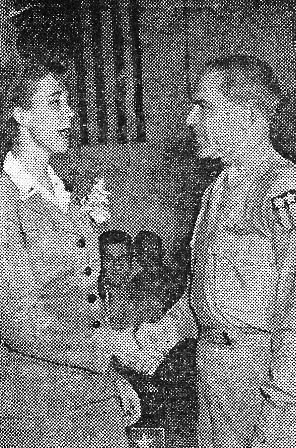 BRIG.-GEN. MERVIN E. GROSS, acting chief of staff, USF CT, congratulates Mrs. Naomi Thompson, director of the new American Red Cross
Club in Chungking. The new club was dedicated on May 31. (Signal Corps photo).
BRIG.-GEN. MERVIN E. GROSS, acting chief of staff, USF CT, congratulates Mrs. Naomi Thompson, director of the new American Red Cross
Club in Chungking. The new club was dedicated on May 31. (Signal Corps photo).
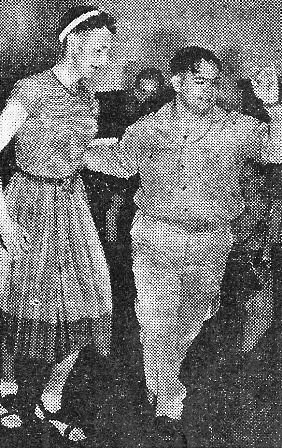 AH, SPRING - T/Sgt. Paul Schommer, Chadron, Neb., and S/Sgt. Milford Phillips, Baltimore, Md., provided one of the high spots on the GI show staged for the opening of Chungking's new American Red Cross Club. (Signal Corps photo).
AH, SPRING - T/Sgt. Paul Schommer, Chadron, Neb., and S/Sgt. Milford Phillips, Baltimore, Md., provided one of the high spots on the GI show staged for the opening of Chungking's new American Red Cross Club. (Signal Corps photo).
 VAULTING 12' 6" Capt. Richard B. Ganslen, Red Bank, N.J., CCC entry at the Chinese-American track meet at the Yunnan Provincial Stadium,
won top honors in this event for his team. A former Columbia University track star, his 14' 5" vault won him the National Collegiate championship
in 1939. (Signal Corps photo).
VAULTING 12' 6" Capt. Richard B. Ganslen, Red Bank, N.J., CCC entry at the Chinese-American track meet at the Yunnan Provincial Stadium,
won top honors in this event for his team. A former Columbia University track star, his 14' 5" vault won him the National Collegiate championship
in 1939. (Signal Corps photo).